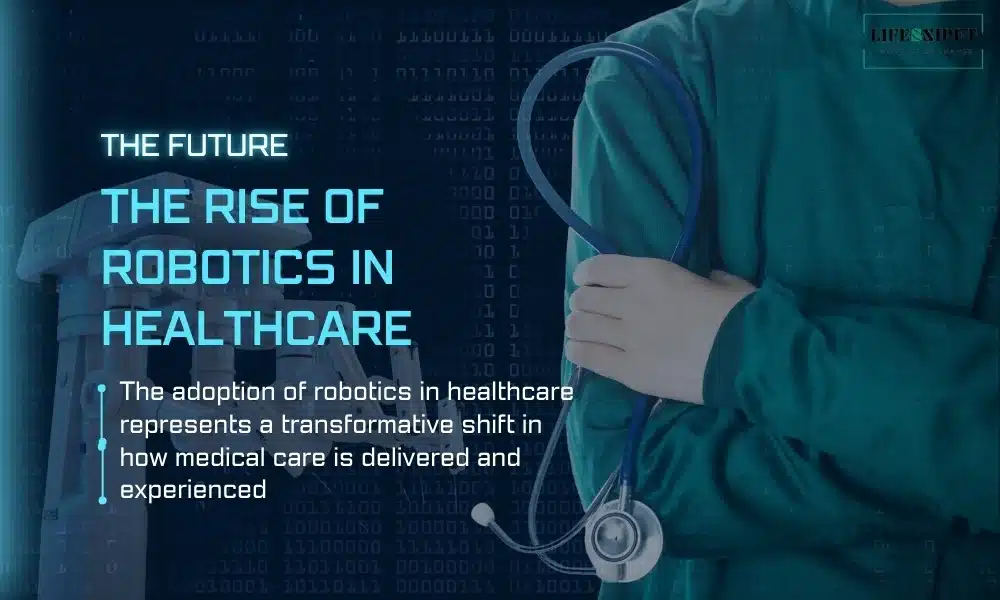In recent years, the healthcare industry has witnessed a technological revolution, with robotics emerging as a game-changing force. Robots are increasingly becoming an integral part of modern healthcare systems from surgical assistants to caregiving companions. This article explores the multifaceted world of robotics in healthcare, examining its current applications, potential benefits, challenges, and prospects.
The Evolution of Robotics in Healthcare
Historical Context
The journey of robotics in healthcare began decades ago with simple automated systems. However, the field has experienced exponential growth in recent years, driven by advancements in artificial intelligence, machine learning, and sensor technologies.
Key Milestones
- 1985: The first surgical robot, PUMA 560, used for neurosurgical biopsies
- 2000: FDA approval of the da Vinci Surgical System
- 2012: Introduction of the first robotic exoskeleton for paralyzed individuals
- 2020: Deployment of robots for COVID-19 response in hospitals worldwide
Current Applications of Robotics in Healthcare
Surgical Robotics
Robotic surgery has revolutionized the operating room, offering enhanced precision, flexibility, and control. The da Vinci Surgical System, for instance, allows surgeons to perform complex procedures with minimal invasiveness.
Rehabilitation Robotics
Robotic exoskeletons and therapy devices are helping patients recover from strokes, spinal cord injuries, and other mobility-limiting conditions. These robots provide consistent, repetitive motions crucial for neuroplasticity and muscle re-education.
Hospital Logistics Robots
Autonomous mobile robots are streamlining hospital operations by transporting medications, lab specimens, and other materials throughout medical facilities, reducing the workload on human staff.
Disinfection Robots
UV-C light-emitting robots are being used to disinfect hospital rooms, reducing the risk of hospital-acquired infections and providing a safer environment for patients and staff.
Telepresence Robots
These robots enable remote consultations and ward rounds, allowing specialists to interact with patients and local healthcare providers from a distance.
Robotic Prosthetics
Advanced robotic limbs with neural interfaces are providing amputees with unprecedented levels of dexterity and sensory feedback.
Companion Robots
Social robots are being deployed in eldercare settings to provide companionship, cognitive stimulation, and basic health monitoring for older adults.
Benefits of Adopting Robotics in Healthcare
Enhanced Precision and Accuracy
Robotic systems, particularly in surgery, can perform actions with a level of precision that surpasses human capabilities, potentially leading to better patient outcomes.
Improved Consistency and Repeatability
Robots can perform repetitive tasks without fatigue, ensuring consistent quality in treatments and procedures.
Reduced Workload on Healthcare Professionals
By taking over routine tasks, robots allow healthcare professionals to focus on more complex aspects of patient care that require human judgment and empathy.
Increased Access to Specialized Care
Telepresence robots and remote-controlled surgical systems can bring specialized care to underserved or remote areas.
Enhanced Patient Safety
Robotic systems can reduce the risk of human error in various healthcare processes, from medication dispensing to surgical procedures.
Cost-Effectiveness in the Long Run
While initial investments in robotic systems can be substantial, they can lead to long-term cost savings through improved efficiency and reduced complications.
Data Collection and Analysis
Robots can continuously collect and analyze patient data, contributing to more informed decision-making and personalized treatment plans.
Challenges in Adopting Robotics in Healthcare
High Initial Costs
The significant upfront investment required for robotic systems can be a barrier for many healthcare institutions, particularly smaller facilities or those in resource-limited settings.
Training and Adaptation
Healthcare professionals need extensive training to effectively use and work alongside robotic systems, which can be time-consuming and costly.
Regulatory Hurdles
The rapid advancement of robotics technology often outpaces regulatory frameworks, creating challenges in approval and implementation processes.
Ethical Considerations
The use of robots in healthcare raises ethical questions about the balance between human touch and technological efficiency, as well as issues of privacy and data security.
Technical Limitations
Current robotic systems still have limitations in terms of adaptability to unexpected situations and the ability to make complex judgments.
Resistance to Change
Some healthcare professionals and patients may be hesitant to embrace robotic technologies, preferring traditional human-centered care.
Maintenance and Reliability
Ensuring robotic systems’ consistent performance and reliability requires ongoing maintenance and technical support.
Case Studies: Successful Implementations of Robotics in Healthcare
Case Study 1: Robotic Surgery at Johns Hopkins Hospital
We are exploring how the integration of the da Vinci Surgical System has improved outcomes in complex procedures.
Case Study 2: Rehabilitation Robotics at the Shirley Ryan AbilityLab
Examining the use of robotic exoskeletons and therapy devices in one of the world’s leading rehabilitation centers.
Case Study 3: Pharmacy Automation at the University of California San Francisco Medical Center
Analyzing the impact of robotic medication dispensing systems on efficiency and error reduction.
The Future of Robotics in Healthcare
Artificial Intelligence and Machine Learning Integration
The combination of AI with robotics is expected to create more adaptive and intelligent healthcare systems capable of learning and improving over time.
Nanorobotics
The development of microscopic robots that can operate at the cellular level holds promise for targeted drug delivery and early disease detection.
Soft Robotics
Advancements in soft, flexible materials are leading to the creation of robots that can interact more safely and naturally with the human body.
Brain-Computer Interfaces
The integration of robotic systems with neural interfaces could revolutionize the treatment of neurological disorders and the control of prosthetic limbs.
Personalized Medicine
Robots equipped with advanced sensors and AI could play a crucial role in tailoring treatments to individual patients based on real-time physiological data.
Home Healthcare Robots
The development of more sophisticated home care robots could enable more patients to receive care in their own homes, reducing the burden on hospitals.
Robotic Drug Discovery
AI-powered robotic systems are expected to accelerate the drug discovery process by autonomously conducting experiments and analyzing results.
Strategies for Successful Adoption of Robotics in Healthcare
Comprehensive Needs Assessment
Healthcare institutions should conduct thorough analyses to identify areas where robotic solutions can provide the most significant benefits.
Phased Implementation
A gradual, step-by-step approach to adopting robotic technologies can help manage costs and allow for smoother integration into existing workflows.
Collaborative Partnerships
Forming partnerships between healthcare providers, technology companies, and academic institutions can drive innovation and share the costs of development.
Continuous Education and Training
Implementing ongoing training programs for healthcare professionals is crucial to ensure the effective use of robotic technologies.
Patient Education and Engagement
Educating patients about the benefits and limitations of robotic technologies can help increase acceptance and trust.
Robust Data Security Measures
Implementing strong cybersecurity protocols is essential to protect sensitive patient data collected and processed by robotic systems.
Regular Evaluation and Optimization
Continuously assessing the performance and impact of robotic systems allows for timely adjustments and improvements.
Ethical and Societal Implications
Job Displacement Concerns
Addressing fears about robots replacing human workers in healthcare and exploring how roles may evolve.
Equity and Access
Ensuring that the benefits of healthcare robotics are accessible to all populations, not just those in well-funded institutions.
Human-Robot Interaction
Exploring the psychological and emotional aspects of patients interacting with robotic caregivers.
Liability and Responsibility
Determining accountability in cases where robotic systems are involved in medical errors or adverse events.
Privacy and Data Ownership
Addressing concerns about the collection, storage, and use of patient data by robotic systems.
Conclusion
The adoption of robotics in healthcare represents a transformative shift in how medical care is delivered and experienced. While challenges remain, the potential benefits in terms of improved patient outcomes, increased efficiency, and expanded access to care are substantial. As technology continues to advance, the integration of robotics in healthcare is likely to accelerate, reshaping the landscape of medical practice.
The key to successful adoption lies in a balanced approach that leverages the strengths of robotic systems while preserving the irreplaceable human elements of care. By addressing challenges head-on, fostering innovation, and maintaining a patient-centered focus, the healthcare industry can harness the power of robotics to create a more effective, efficient, and compassionate system of care.
As we look to the future, it’s clear that robotics will play an increasingly vital role in healthcare. From enhancing surgical precision to providing companionship for the elderly, robots are poised to touch nearly every aspect of patient care. However, it’s crucial to remember that these technologies are tools to augment and support human caregivers, not replace them. The ultimate goal should be to create a harmonious integration of human expertise and robotic capabilities, working together to provide the best possible care for patients around the world.
The journey of adopting robotics in healthcare is just beginning, and the coming decades promise exciting developments that could revolutionize medicine as we know it. As researchers, healthcare providers, policymakers, and patients, we all have a role to play in shaping this future. By embracing innovation while carefully considering its implications, we can work towards a healthcare system that leverages the best of both human compassion and technological advancement.
In conclusion, the adoption of robotics in healthcare is not just about implementing new technologies; it’s about reimagining the very nature of healthcare delivery. It’s a path that offers immense potential for improving human health and well-being, but one that must be navigated with care, wisdom, and a steadfast commitment to the core values of medicine. As we continue to explore and expand the role of robotics in healthcare, we move closer to a future where advanced technology and human care work in perfect synergy, offering hope for better health outcomes for people around the globe.
FAQs
Q1. How are robots used in healthcare?
Robots in healthcare are used for various tasks, including performing surgeries, assisting in rehabilitation, delivering medications and supplies, and disinfecting facilities.
Q2. What are the benefits of using robots in healthcare?
The benefits include increased precision and consistency in surgeries, reduced risk of infection, enhanced patient care through personalized treatment plans, and improved efficiency in hospital operations.
Q3. Are there any risks associated with using robots in healthcare?
Potential risks include technical malfunctions, high initial costs, the need for specialized training for healthcare professionals, and concerns about patient privacy and data security.
Q4. How do robots improve patient outcomes in healthcare?
Robots improve patient outcomes by providing minimally invasive surgical options, reducing recovery times, ensuring accurate medication administration, and offering consistent and reliable support in rehabilitation and patient care.

Welcome to LifeSnipet! At LifeSnipet, we’re your ultimate source for the latest health updates. Specializing in health and fitness-related diseases, we delve deep into Ayurvedic techniques, providing you with a comprehensive understanding of well-being. Explore our real-time updates, detailed articles, and ancient Ayurvedic wisdom for a holistic approach to health. Embark on a journey to a healthier, vibrant life with LifeSnipet – where your well-being is our priority!











